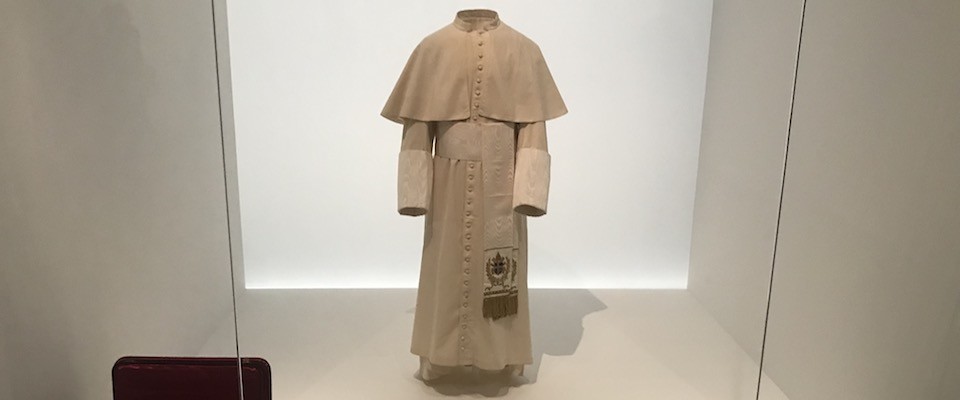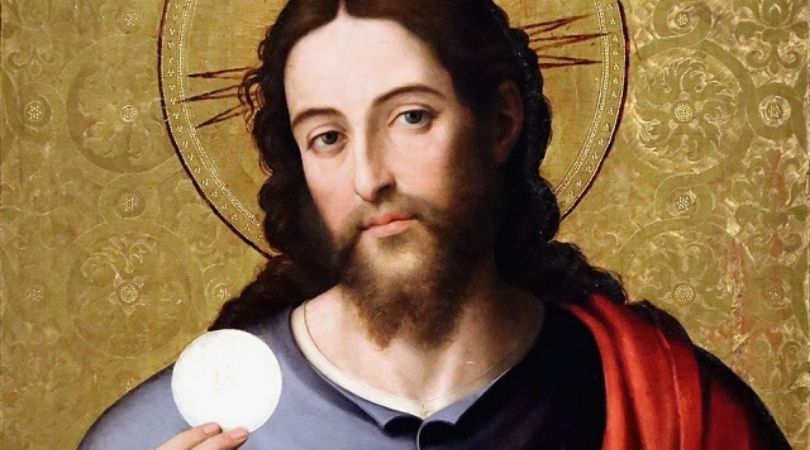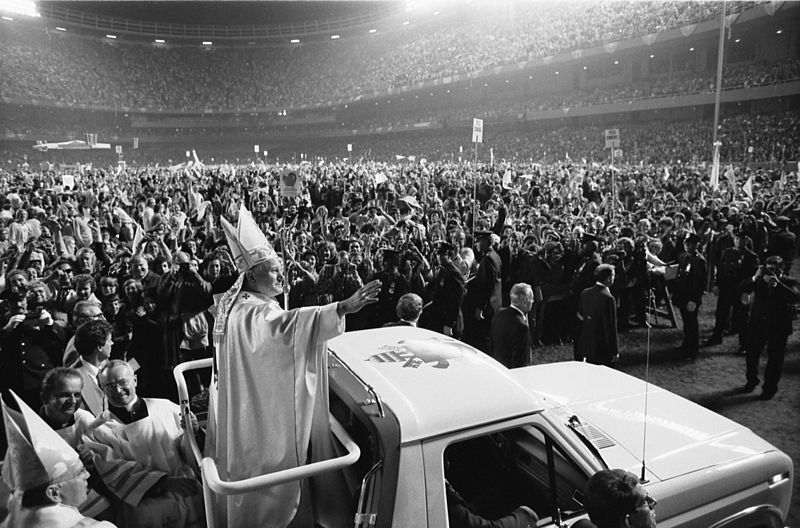A few hours before the Met Gala began, Cardinal Dolan stood opposite the Temple of Dendur and proclaimed Christ. He was there for the press preview of the new exhibit “Heavenly Bodies: Fashion and the Catholic Imagination.” He had neither planned the exhibit nor authorized it. Men in Rome had done that, sending the sacred relics of several holy popes for display in the midst of Vanity Fair. Already there were competing attractions. Cameramen mobbed Donatella Versace and Anna Wintour, while Fr. James Martin, SJ, and a woman in a black moiré biretta each attracted small crowds.
When the press conference ended, the fashionistas spilled into the galleries. Men in Thom Browne suits and women with Chanel handbags admired a bondage mask draped in rosaries and gawked at mannequins dressed in papal drag, before going to view the sacred clothes worn by the successors of St. Peter.
According to the organizers, this display of papal vestments and various tasteless, indecent, and blasphemous fashion items is meant to illustrate “the Catholic imagination.” Whenever someone uses the phrase—or its close cousin, “the sacramental imagination”—I know that I am about to hear a tedious disquisition on Flannery O’Connor, or an account of Catholic belief that muddles error and truth. In this regard, the exhibition does not disappoint.
At the press conference, a curator read from a book by Andrew Greeley: “Catholics live in an enchanted world: a world of statues and holy water, stained glass and votive candles, saints and religious medals, rosary beads and holy pictures.” And what faith do all these things express? According to Greeley, a kind of bourgie pantheism: “These Catholic paraphernalia are merely hints of a deeper and more pervasive religious sensibility that inclines Catholics to see the Holy lurking in creation.”
In the exhibition catalogue, David Tracy dilates on this idea. “It has become increasingly difficult for persons outside or even inside Catholicism to describe, much less define, what distinguishes Catholic Christianity.” Unwilling to refer to traditional ecclesiological and dogmatic claims, Tracy decides that Catholics are united by a set of clichés. They “believe (like Albert Camus) that there is more to admire in human beings than to despise.” They believe that “humanity is on the whole trustworthy.”
This is a way of talking around the actual content of the faith. What the sacramental imagination should mean, first of all, is actual belief in the sacraments: Marriage is indissoluble and ordained by God; Christ is present in the Eucharist and must be revered. My Catholic grandparents, who feared for my soul because I was not baptized as a child, were better exemplars of the sacramental imagination than every ex-Catholic designer combined.
The Catholic imagination only really exists where it expresses, affirms, conforms to sacramental reality and dogmatic truth. My favorite authentic expression of it appears in a letter Pope Innocent IV wrote in 1245 to Guyuk Khan, whose men had been ravaging the Catholic lands of Poland and Hungary. The pope rebuked the khan for disrupting the harmony God had established in nature:
Not only men, but also unreasoning beasts, nay even the material elements of the earth that go into the building of the universe, are as if through a natural bond united with one another, and bound together, after the example of heavenly spirits: for all these traces the Creator of the world has exhibited in all things, so that a lasting and irrefragable bond of peace surrounds all the different orders of being.
This is a beautiful vision, but as its invocation in a diplomatic document should indicate, it had profound religious and political implications. Visitors to the Met exhibit would be foolish to overlook them.
Begin with the jewel-studded clasp worn by Benedict XIII, whose sacramental imagination led him in 1725 to rule that no confession could be sacramentally effective without the intention to sin no more.
Then look at the white silk tafetta mantle that belonged to Benedict XIV, who in 1743 rebuked the Polish bishops for allowing the dissolution of marriages without due cause.
And here is a diamond-studded ring, which the Bourbon princess Marie Adélaïde Clotilede gave to Pius VI in 1775. Pius’s resistance to the French Revolution stemmed from his Catholic imagination, which saw society as a matter of carefully ordered hierarchy. He believed that social order “is like harmony, which derives from the agreement of many sounds.”
Now on to a fiddleback chasuble with flashing gold tinsel worn by Pius VII, whose Catholic imagination led him in 1821 to condemn those who “hold in contempt the Sacraments of the Church … and treat with derision the Mysteries of the Catholic Religion.”
There is a dazzling diamond clasp given to Leo XIII by Maria Cristina, queen regent of Spain. Leo’s Catholic imagination led him not only to challenge the inhumanity of the Industrial Revolution but also to condemn in 1880 “the baneful heresy obtaining among Protestants touching divorce and separation.”
Here is the aquamarine pectoral cross that Leo XIII gave to Giuseppe Sarto, who became Pius X. In 1907 Pius issued the encyclical Pascendi, which warned that “For the Modernists the Sacraments are mere symbols or signs.”
Or here is a cope of Benedict XV, that great lover of peace, whose understanding of the sacramental priesthood compelled him to rule in 1916 that “images of the Blessed Virgin Mary wearing priestly vestments are not approved.”
And here is a gold chasuble of Pius XI, stitched with scenes of crusade. His sacramental imagination obliged him in 1930 to issue Casti Connubii, which condemned “those wicked parents who seek to remain childless, and failing in this, are not ashamed to put their offspring to death.”
Catch the glint of a ring worn by Pius XII, who asked the nations to “follow our peaceful King who taught us to love not only those who are of a different nation or race, but even our enemies.”
And look at the red shoes of John Paul II, who in 1993 issued Veritatis Splendor, which affirmed “objective norms of morality valid for all people of the present and the future, as for those of the past.”
We should attend to the real Catholic imagination and not its sentimental counterfeit. The same faith that gave rise to these beautiful baubles proposed views on sexuality and social order that are contrary to the spirit of the age. It is foolish to suppose that either the Church’s teaching or its relics are mere artefacts that now have lost their power. These beautiful copes, stoles, clasps, and rings still move men—still have the power Leo XIII acknowledged in Testem Benevolentiae when he advised priests in America to spread the faith “by the pomp and splendor of ceremonies” as well as “by setting forth that sound form of doctrine.” In the Met’s carnival atmosphere, their splendor seems all the more radiant.
Matthew Schmitz is senior editor of First Things and a Robert Novak Journalism Fellow.
https://www.firstthings.com/web-exclusives/2018/05/catholic-imagination-and-its-counterfeit







